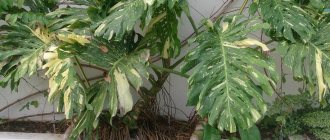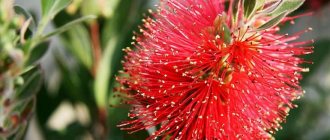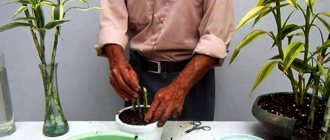What qualities are not attributed to the evergreen beauty: both magical and healing. There is no doubt about the latter, because the essential oils contained in myrtle actually have bactericidal properties. Such a tree in an apartment can purify the air and protect owners from pathogenic microflora and viruses. The undoubted advantage is beauty. To experience the awe of the lush flowering, you will need to make a lot of effort; it is not for nothing that flower growers call it “sissy”. How to grow myrtle, care at home, leaves drying, the reasons that caused leaf fall, how to get rid of pests - these and many other issues are discussed below in the article.
Description of the myrtle flower
The tree-like flower grows very slowly, a maximum of 2 mm per year. The height it reaches at home is just over 60 cm. It prefers a substrate made of equal parts of sand, peat, humus and turf. It blooms at the age of five, usually in the first half of summer. Requires good lighting, but the scorching sun can destroy the plant, as well as lack of moisture.
Healthy myrtle
Feeding is carried out in the spring-summer season, no more than once a week. If pruning is practiced, it is done annually at the beginning of the growing season.
For your information! Young flowers are replanted every year, adults - once every 2-3 years.
Lack or excess moisture
Myrtle is a moisture-loving plant, so it needs abundant and frequent watering. It is necessary to carry out this procedure regularly to maintain the attractive appearance of the shrub. If there is too little moisture, the myrtle begins to dry out. You can understand that it is time to water the myrtle, first of all, by its leaves. Their color becomes less saturated, then they turn yellow, acquire a brown tint, and as a result they dry out and curl. All this leads to the falling of leaves and can lead to the death of the plant.
However, excess moisture also negatively affects the crop. If water stagnates in the soil, the root system rots. One of the signs of this process is wilting of foliage.
Problems in growing myrtle flowers
Myrtle - care at home, how to reanimate if it has dried out
Even if you comply with all the necessary requirements, the bush may get sick and lose its leaves. This is the result of mistakes that can most often be corrected.
The first signs of a flower's malaise can be determined by its appearance with the naked eye. A whitish coating may appear on the leaves, which subsequently appears as spots; the leaves begin to gradually curl and then fall off. This indicates that the tree is sick. There may be several reasons why a myrtle tree crumbles:
- untimely watering and insufficient air humidity in the room;
- improper feeding;
- excessive watering;
- bad light;
- damage by insect pests.
What are the benefits of myrtle berries?
Myrtle
are used against influenza, for its prevention, as well as for the treatment of complications against influenza, as they have a gentle effect on the body. It is especially good to give to children with allergies, when antibiotics are contraindicated.
Interesting materials:
How to restore deleted Opera to your computer? How to recover deleted messages on Facebook? How to recover deleted correspondence on Instagram Direct? How to recover deleted correspondence in Viber on your phone? How to recover a deleted Facebook ad campaign? How to restore a deleted page in VK without a phone number? How to recover a deleted Windows 10 account? How to recover a deleted post on Facebook? How to recover deleted data on a flash drive? How to recover deleted data from iPhone?
What to do if the cause is excessive watering of the flower
How to propagate myrtle at home from cuttings
The flower requires daily watering, and the soil should be slightly moist, otherwise drying out and curling of the leaves cannot be avoided. In the autumn-winter season, watering is slightly reduced, but humidity is maintained by systematic spraying.
Excess moisture from excessive watering has a detrimental effect on the condition of the flower: the leaves and ends of the shoots begin to turn black. Since the roots do not receive the required amount of oxygen, the process of decay begins. This is immediately reflected in the change in the general condition and color of the crown. The tree seems to wither.
You can help the flower in two ways: reducing watering with systematic light loosening (this will allow the soil to dry out) or replanting it into a soil of a different composition. To do this, carefully wash the roots with clean water and mercilessly cut off any rotten roots. After planting in a new substrate, the plant is covered with a transparent bag and left for some time without watering.
Transfer
If the myrtle's growth has slowed, it's time to replant it in a larger pot. Always use a pot with a hole in the bottom and place something underneath for drainage, such as gravel or some broken pottery. Myrtle requires good drainage. Properly grown, it is great for landscaping an apartment or office. If the myrtle has dried up, it means that the listed rules have been violated. You can try replanting it in a new pot and adjusting the conditions. Maybe new shoots will come from the root.
What to do when the reason lies in lighting and temperature conditions
Houseplant myrtle - care at home
If, with proper care of myrtle at home, the leaves of the evergreen beauty dry out, this may indicate a lack of light, direct sunlight and unsuitable temperature conditions. In the winter months, the plant feels better in a cool room at a temperature of 12 °C; in the summer months, it is optimal from 17 °C to 24 °C. Absolutely does not tolerate exposure to direct sunlight, preferring diffused lighting. Knowing these subtleties, you can easily create comfortable conditions by placing him in a favorable environment.
Important! The lack of sunlight is compensated using a lamp.
Flower roots
Pests and how to deal with them
It happens that despite the excellent care of myrtle at home, the leaves dry out and the flowers and branches fall off. This is often associated with the appearance of insect pests.
- Aphid
The small insect sticks to the back of the leaf and drinks the juices from the plant. This pest can also be seen on petioles and large branches. Aphids are able to mimic and take on the color of the plant on which they live. Most often, aphids are green, gray or black. It multiplies at incredible speed and quickly destroys the tree.
- Spider mite
Leaves covered with small sticky cobwebs are affected by the pest. Spider mites are too small to be seen with the naked eye, but the effects of their activities are very noticeable. It multiplies quickly and can infect neighboring plants.
- Shchitovka
The greatest threat to the health of myrtle is the scale insect. This parasite is dangerous because it is difficult to get rid of. He will quickly take away all the nutritious juices of the myrtle. If a white or colorless sticky coating appears on the leaves, then this is a sign of scale infestation.
Shchitovka
- Mealybug
A whitish coating on leaves, petioles, and shoots is a characteristic sign of the appearance of a mealybug. The plant becomes dull, turns pale and dries out. First it sheds its leaves, and then dies entirely.
- Whitefly
A pest such as whitefly actively drinks tree sap. It looks like a very small white moth and is capable of multiplying rapidly. Getting rid of the pest is not easy; you will have to do 4 insecticide treatments.
Why are pests and parasites dangerous?
All pests suck the juices from the plant. Because of this, the myrtle withers and dries up.
Attention! Parasites, as a rule, multiply very quickly and form huge colonies that can spread to neighboring flowers and trees.
How to deal with them
Saving a plant from pests is quite difficult. First, you need to rinse the myrtle in the shower so that the stream of water washes away the insects. The largest ones can be removed by hand. The myrtle is then treated with insecticides. The drug "Aktara" helps against aphids and mealybugs.
Most insecticides do not affect scale insects and whiteflies, so pests must be removed manually. Then the myrtle is washed with soapy water and then treated with Actellik.
Mealybug
Maintaining good maintenance conditions will protect the tree from pests. Spider mites do not tolerate moist air, so myrtle is regularly sprayed with water and a cup of liquid is placed next to it. Water the tree only with settled water.
If the myrtle dries out and drops its leaves, every gardener should know what to do in this case. If there is not enough information, you can always read specialized literature on this topic or ask more experienced experts. Even if the myrtle has dried up, it can be revived, and then it will delight the owner for a long time with its flowering and beneficial properties.
If excessive feeding is to blame, how do you save a flower?
Excessive feeding can not only stop the growth of the plant, but also lead to its death. Frequent and incorrect application of fertilizers leads to their accumulation in the soil, which causes burns to the root system. The tree will begin to dry out and gradually shed its leaves.
An urgent transplant into fresh soil will be required. First, you need to thoroughly rinse the roots from dangerous deposits, cut off the dead ones, and only then replant. Unfortunately, if there is an excess of feeding, only this risky method will save the flower from inevitable death.
Note! Yellowing of the leaves is often observed immediately after purchasing a flower. Botanists associate such changes with a change in environment that causes stress. Adaptation to new conditions is much easier if the new “tenant” is placed in a slightly dark place for several days and periodically irrigated with a spray bottle.
Useful tips for growing
- Myrtle will bloom profusely in summer if it is provided with a cool winter and good lighting during the growing season.
- You can feed the tree with fertilizer for orchids or citrus fruits. The concentration of the latter should be halved and a teaspoon of apple cider vinegar should be added to 2 liters of water.
- The substrate must be loose. In addition to the usual ingredients, you can add charcoal and chopped coconut fiber. A little pine bark in the soil will not only loosen and disinfect it, but also neutralize excess salts that accumulate in the pot when watering.
Pest attack
It happens that the temperature is correct, the humidity is sufficient, even the light conditions are met, but the myrtle tree dries out, what should I do? Perhaps small pests have settled in the dense crown of the flower. It, like other houseplants, is attacked by the same types of tiny insects.
- Aphid. Entire colonies of this parasite settle on the underside of leaves and feed on their sap, causing them to begin to curl, dry out, and then fall off. To get rid of it, first the tree (crown down) is thoroughly washed under running water, allowed to dry and sprayed with any insecticidal preparation. An actor is more suitable.
- Shield. It is capable, like aphids, of feeding on plant sap. The presence of a parasite can be determined by a characteristic sticky coating on both leaves and shoots. First, you need to remove it with a cotton swab or a piece of sponge soaked in a soap solution (use laundry soap), and then treat it with Actellik, which is good for helping against scale insects.
Insect attack
- Mealybug. It is very noticeable on plants: a whitish fluffy coating covers both the branches and the crown. Before spraying with actara or other insecticide, pests are first removed.
- Spider mite. Both the crown and shoots are enveloped in cobwebs. First you need to spray the flower with an infusion of tobacco dust and wipe each leaf and twig, then treat it with Actellik.
- Whitefly. In appearance it resembles a tiny moth. Like aphids and scale insects, they settle in colonies, taking a liking to the inside of the foliage. It is difficult to get rid of this parasite in one go, since the pest larvae are covered with a thick film that makes it difficult for chemicals to penetrate. Therefore, you will have to resort to processing several times. Each time, large individuals are first removed by hand and the plant is washed with a soap solution, after which it is treated with Actellik.
- Thrips. They are identified by the presence of light spots on the upper part of the leaves and blackish dots on the back side. They are dangerous because they harm not only the greenery, but also the buds. You can treat the tree with an infusion of tobacco dust and garlic; if that doesn’t help, resort to Actellik.
Important! When using insecticidal preparations, you must follow the instructions. These are toxic substances, their dose and concentration must be taken into account when preparing solutions.
Why does myrtle dry out?
It's no secret that plants are susceptible to various diseases. In addition, they can be affected by pests. Myrtle is no exception; the shrub cannot be protected from absolutely all ailments. One of the most common problems gardeners face is myrtle leaves drying out. What could be the cause of this illness? Factors contributing to yellowing and falling leaves can be divided into two groups: improper care and exposure to insects. The first group includes the following reasons:
- Lack or excess of moisture.
- Incorrect temperature.
- Unsuitable fertilizers.
- Bad light.
The second group of reasons involves the impact of aphids, scale insects, mealybugs, whiteflies and spider mites on the plant. They also “have a hand” in causing the myrtle to dry up. We will look further at how to save the plant.
Myrtle dries and drops leaves: what to do
When the reasons are insufficient watering, dry air and exposure to sunlight, the leaves first begin to turn yellow and then fall off. If measures are not taken in time, then in the near future you can see a depressing picture: bare branches that once delighted with an abundance of greenery. This indicates that the myrtle is drying up, but what to do in this case? Urgent rescue! Remove from the sun (or from the radiator), create comfortable conditions (cool, air humidity). The following procedures will help in the initial stages:
The flower dies before your eyes
- The pot with the flower is immersed in a container of water and wait 10-15 minutes. During this time, water will penetrate through the drainage holes and completely saturate the ground. After a certain period of time, the pot is removed and placed on a tray to drain the water. Water from the pan must be constantly drained to avoid stagnation;
- water generously, spray with a spray bottle and cover with a plastic bag, not forgetting to drain excess liquid from the pan. Place a small bowl of water nearby. The technique has a greater effect if carried out for at least three days in a row.
Important! You should carefully ensure that the liquid in the pan does not stagnate. It is necessary to drain after each watering.
Bad light
With a lack of light, the process of photosynthesis is disrupted, so the plant produces insufficient chlorophyll and withers because of this. It is necessary to move the myrtle into a well-lit room.
Another danger lies in sunburn. This happens when the tree is left under the scorching sun or next to a south-facing window. Direct sunlight burns the leaves and petals of myrtle, causing them to dry out. And then the tree sheds its withered leaves, covered with burns.
If a myrtle tree dries out due to inappropriate light conditions, everyone needs to know what to do and how to help the plant. We urgently need to move the myrtle to a shaded place or curtain the window. Myrtle loves diffused lighting.
If myrtle has dried up, how to revive the plant
Often the measures taken do not give the desired effect, and the plant continues to dry out. Of course, this situation does not make anyone happy. And yet, if all the myrtle leaves have dried up, what should you do? Even in this case, there is no need to despair and give up. You can try to revive your green pet.
To do this, you should carefully examine the branches, check how easily they bend, and whether deformation occurs. Good flexibility indicates sufficient elasticity, which means that all is not lost. You need to additionally check the roots by digging up the ground a little. If they have not had time to dry completely, then there is hope for salvation.
For your information! Reanimation is not a complicated, but very effective way to revive a plant. First, the flower must be watered abundantly, and then the whole thing must be placed in a large plastic bag. At the same time, leave a hole that will provide air access.
Another way: make a mini-greenhouse. For small myrtle sizes, an empty plastic bottle of 5 to 10 liters is perfect. It is cut in the middle, a pot with a flower is placed inside and the top is covered. The neck serves as a ventilation hole to prevent the rotting process from starting.
This procedure must be carried out daily for three weeks. In this case, it will not be superfluous to spray with settled water purified from chlorine. As an additional prevention, spray with a solution of the drug Epin (6-8 drops per 1 liter) once a week. It will help awaken the tree’s reserve forces and stimulate the growth of new cells.
Important! The solution must be prepared immediately before use!
With diligence and patience, after 3-4 weeks (sometimes it takes a little longer), young leaves can be seen growing on the branches. When this does not happen, it is worth making a small longitudinal cut in the bark of the tree, slightly separating the top layer and looking at the color under the cut. A green tint indicates continued vital activity and gives hope for recovery. The trunk may turn brown if the myrtle has dried out, so what should you do? You'll have to come to terms with the loss.
A beautiful and healthy flower that requires close attention
In order to never see a myrtle flower dry up again or face resuscitation problems, you should take more careful care of the plant. Beginning flower growers should study all the intricacies of care and possible diseases before purchasing this species. Only then will the shrub delight its owners with the luxurious appearance and fragrance of fluffy flowers.
Nesquik Opti-Start instant cocoa drink, 1 kg (package)
316 ₽ More details
Nesquik Opti-Start instant cocoa drink, 1 kg (package)
339 ₽ More details
Bouquets of orchids
How to rehabilitate a dried tree?
Having noticed the first signs of myrtle disease, such as yellowing of individual leaves, their dryness, curling, whitish or brown spots, the presence of mold at the base of the trunk or on the surface of the ground, it is necessary to take measures as soon as possible to eliminate those factors that led to such unpleasant consequences. In most cases, the tree will need the following restoration procedures:
Removing dead fragments
To check whether a dried myrtle can survive, you need to examine its main branches - if they bend and do not break under physical stress, the chances are quite high. At the same time, it makes sense to remove all withered leaves and dehydrated parts of the crown so that they do not interfere with the emergence of new shoots. You should work extremely carefully with a rotten root system, cutting off the affected areas with a sharp knife/scissors and immediately treating the edges with a growth stimulator (for example, Kornevina powder).
bs_mirt_obikn_23456.jpg
Transplantation into a high-quality substrate
The optimal soil mixture for myrtle is nutritious, but fairly loose soil based on vermicompost, with a neutral or slightly acidic pH value - from 5.0 to 8.0. From the store offers, soil for palms and citrus fruits is best suited. It should contain turf soil, humus and sand in equal proportions. It will also be useful to add coconut sawdust, crushed charcoal (ash), peat, and ceramic chips.
The suitable diameter of the container for the tree is 7-10 cm larger than the previous one. At the bottom of the pot you need to make a drainage hole, fill in a 3-5 centimeter ball of expanded clay, small pebbles, shells or crushed walnut shells, a little substrate, transfer well-moistened roots there with or without an old lump of earth and compact the remaining soil around the base of the trunk.
peresadka-mirta.jpg
Proper regular watering
For the regeneration of dried myrtle, constant soil moisture is very important, but in no case should stagnation of water be allowed, especially in conjunction with hypothermia. It is recommended to water this plant in small portions, not allowing the soil to dry out to a depth of more than 1-2 cm. Water should be used that is settled, soft, and slightly warmer than the air temperature in the room.
5.jpg
Greenhouse conditions and spraying
As practice shows, daily spraying of its crown with a weak solution of the growth stimulator “Epin” (1-5 drops of the drug per liter of warm water) helps to speed up the rehabilitation of myrtle very effectively. In this case, the tree must be at a temperature not lower than +20...22 °C and be protected from drafts. To maintain a comfortable microclimate, it is worth equipping a mini-greenhouse around the plant from a large plastic bottle, film or transparent plastic bag.
1f728e4898132fbe0d931e705fbc6771_h-3342.jpg
Full lighting
Like all representatives of subtropical flora, the Myrthus species needs at least 12-15 hours of daylight and plenty of ultraviolet light all year round. In summer, a well-lit place on a balcony, terrace, in the garden or near a south window will suffice, but in winter in the middle climate zone it is unlikely to be able to do without additional lighting. This can be achieved using fluorescent lamps or specialized phytolamps for indoor flowers. It is better to mount them from above - this way the crown will form evenly and symmetrically.
podsvetka-dlya-komnatnyih-tsvetov-2-1024×768.jpg
Fertilizer application
To strengthen the health of damaged myrtle, from the beginning of spring it must be watered every week with small doses of nitrogen fertilizers, which help to build up green mass and form buds of future flowers. During the active growing season, that is, from May-June to September, mineral complexes for decorative deciduous crops will be especially useful. They can also be applied once every 7-14 days, following the instructions on the packaging of the selected drug.
podkormka-komnatnyh-rasteniy.jpg
Insect control
Spots, darkening, cobwebs, sticky white, gray or black coating on leaves or branches are clear signs of a tree being infected by pests: aphids, thrips, scale insects, spider mites, etc. To combat them, give the plant a bath in warm soapy water (20 grams laundry soap per 1 liter of liquid), wipe the damaged areas with the same solution, rinse with plain water, and then spray with insecticides. If insects have settled in the soil (whiteflies, mealybugs, podura), only watering with special chemicals and replanting in new soil with preliminary washing of the roots from the previous soil will help.
35480.pjo03o.840.jpg
As a rule, the measures listed are enough to resume the development of a withered myrtle tree and help it regain its former luxurious appearance.
Inappropriate feeding
Imagine: you water the plant correctly, the temperatures are within normal limits, but the myrtle leaves still dry out. What to do in this case? The reason for the wilting of foliage may lie in incorrectly selected fertilizers. Fact: much more often myrtle suffers from an excess of minerals than from a lack of them, because owners (especially people who have not kept myrtle before) fertilize too often. The situation is especially dangerous when nitrogenous minerals accumulate in the soil. In small quantities they will benefit the plant, but if you apply nitrogen fertilizers in excessively large quantities, they will simply burn the roots of the plant. This, in turn, affects the color and density of the foliage.











